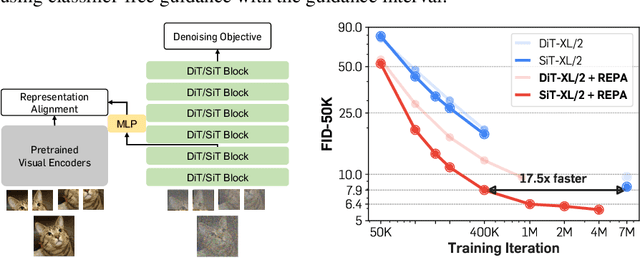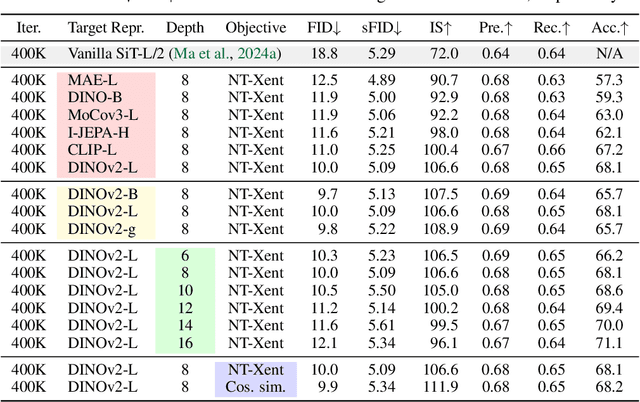Huiwon Jang
ContextVLA: Vision-Language-Action Model with Amortized Multi-Frame Context
Oct 05, 2025Abstract:Leveraging temporal context is crucial for success in partially observable robotic tasks. However, prior work in behavior cloning has demonstrated inconsistent performance gains when using multi-frame observations. In this paper, we introduce ContextVLA, a policy model that robustly improves robotic task performance by effectively leveraging multi-frame observations. Our approach is motivated by the key observation that Vision-Language-Action models (VLA), i.e., policy models built upon a Vision-Language Model (VLM), more effectively utilize multi-frame observations for action generation. This suggests that VLMs' inherent temporal understanding capability enables them to extract more meaningful context from multi-frame observations. However, the high dimensionality of video inputs introduces significant computational overhead, making VLA training and inference inefficient. To address this, ContextVLA compresses past observations into a single context token, allowing the policy to efficiently leverage temporal context for action generation. Our experiments show that ContextVLA consistently improves over single-frame VLAs and achieves the benefits of full multi-frame training but with reduced training and inference times.
Efficient Long Video Tokenization via Coordinate-based Patch Reconstruction
Nov 26, 2024



Abstract:Efficient tokenization of videos remains a challenge in training vision models that can process long videos. One promising direction is to develop a tokenizer that can encode long video clips, as it would enable the tokenizer to leverage the temporal coherence of videos better for tokenization. However, training existing tokenizers on long videos often incurs a huge training cost as they are trained to reconstruct all the frames at once. In this paper, we introduce CoordTok, a video tokenizer that learns a mapping from coordinate-based representations to the corresponding patches of input videos, inspired by recent advances in 3D generative models. In particular, CoordTok encodes a video into factorized triplane representations and reconstructs patches that correspond to randomly sampled $(x,y,t)$ coordinates. This allows for training large tokenizer models directly on long videos without requiring excessive training resources. Our experiments show that CoordTok can drastically reduce the number of tokens for encoding long video clips. For instance, CoordTok can encode a 128-frame video with 128$\times$128 resolution into 1280 tokens, while baselines need 6144 or 8192 tokens to achieve similar reconstruction quality. We further show that this efficient video tokenization enables memory-efficient training of a diffusion transformer that can generate 128 frames at once.
Representation Alignment for Generation: Training Diffusion Transformers Is Easier Than You Think
Oct 09, 2024



Abstract:Recent studies have shown that the denoising process in (generative) diffusion models can induce meaningful (discriminative) representations inside the model, though the quality of these representations still lags behind those learned through recent self-supervised learning methods. We argue that one main bottleneck in training large-scale diffusion models for generation lies in effectively learning these representations. Moreover, training can be made easier by incorporating high-quality external visual representations, rather than relying solely on the diffusion models to learn them independently. We study this by introducing a straightforward regularization called REPresentation Alignment (REPA), which aligns the projections of noisy input hidden states in denoising networks with clean image representations obtained from external, pretrained visual encoders. The results are striking: our simple strategy yields significant improvements in both training efficiency and generation quality when applied to popular diffusion and flow-based transformers, such as DiTs and SiTs. For instance, our method can speed up SiT training by over 17.5$\times$, matching the performance (without classifier-free guidance) of a SiT-XL model trained for 7M steps in less than 400K steps. In terms of final generation quality, our approach achieves state-of-the-art results of FID=1.42 using classifier-free guidance with the guidance interval.
Adversarial Robustification via Text-to-Image Diffusion Models
Jul 26, 2024



Abstract:Adversarial robustness has been conventionally believed as a challenging property to encode for neural networks, requiring plenty of training data. In the recent paradigm of adopting off-the-shelf models, however, access to their training data is often infeasible or not practical, while most of such models are not originally trained concerning adversarial robustness. In this paper, we develop a scalable and model-agnostic solution to achieve adversarial robustness without using any data. Our intuition is to view recent text-to-image diffusion models as "adaptable" denoisers that can be optimized to specify target tasks. Based on this, we propose: (a) to initiate a denoise-and-classify pipeline that offers provable guarantees against adversarial attacks, and (b) to leverage a few synthetic reference images generated from the text-to-image model that enables novel adaptation schemes. Our experiments show that our data-free scheme applied to the pre-trained CLIP could improve the (provable) adversarial robustness of its diverse zero-shot classification derivatives (while maintaining their accuracy), significantly surpassing prior approaches that utilize the full training data. Not only for CLIP, we also demonstrate that our framework is easily applicable for robustifying other visual classifiers efficiently.
Modality-Agnostic Self-Supervised Learning with Meta-Learned Masked Auto-Encoder
Oct 25, 2023Abstract:Despite its practical importance across a wide range of modalities, recent advances in self-supervised learning (SSL) have been primarily focused on a few well-curated domains, e.g., vision and language, often relying on their domain-specific knowledge. For example, Masked Auto-Encoder (MAE) has become one of the popular architectures in these domains, but less has explored its potential in other modalities. In this paper, we develop MAE as a unified, modality-agnostic SSL framework. In turn, we argue meta-learning as a key to interpreting MAE as a modality-agnostic learner, and propose enhancements to MAE from the motivation to jointly improve its SSL across diverse modalities, coined MetaMAE as a result. Our key idea is to view the mask reconstruction of MAE as a meta-learning task: masked tokens are predicted by adapting the Transformer meta-learner through the amortization of unmasked tokens. Based on this novel interpretation, we propose to integrate two advanced meta-learning techniques. First, we adapt the amortized latent of the Transformer encoder using gradient-based meta-learning to enhance the reconstruction. Then, we maximize the alignment between amortized and adapted latents through task contrastive learning which guides the Transformer encoder to better encode the task-specific knowledge. Our experiment demonstrates the superiority of MetaMAE in the modality-agnostic SSL benchmark (called DABS), significantly outperforming prior baselines. Code is available at https://github.com/alinlab/MetaMAE.
Unsupervised Meta-Learning via Few-shot Pseudo-supervised Contrastive Learning
Mar 02, 2023



Abstract:Unsupervised meta-learning aims to learn generalizable knowledge across a distribution of tasks constructed from unlabeled data. Here, the main challenge is how to construct diverse tasks for meta-learning without label information; recent works have proposed to create, e.g., pseudo-labeling via pretrained representations or creating synthetic samples via generative models. However, such a task construction strategy is fundamentally limited due to heavy reliance on the immutable pseudo-labels during meta-learning and the quality of the representations or the generated samples. To overcome the limitations, we propose a simple yet effective unsupervised meta-learning framework, coined Pseudo-supervised Contrast (PsCo), for few-shot classification. We are inspired by the recent self-supervised learning literature; PsCo utilizes a momentum network and a queue of previous batches to improve pseudo-labeling and construct diverse tasks in a progressive manner. Our extensive experiments demonstrate that PsCo outperforms existing unsupervised meta-learning methods under various in-domain and cross-domain few-shot classification benchmarks. We also validate that PsCo is easily scalable to a large-scale benchmark, while recent prior-art meta-schemes are not.
AltUB: Alternating Training Method to Update Base Distribution of Normalizing Flow for Anomaly Detection
Oct 26, 2022



Abstract:Unsupervised anomaly detection is coming into the spotlight these days in various practical domains due to the limited amount of anomaly data. One of the major approaches for it is a normalizing flow which pursues the invertible transformation of a complex distribution as images into an easy distribution as N(0, I). In fact, algorithms based on normalizing flow like FastFlow and CFLOW-AD establish state-of-the-art performance on unsupervised anomaly detection tasks. Nevertheless, we investigate these algorithms convert normal images into not N(0, I) as their destination, but an arbitrary normal distribution. Moreover, their performances are often unstable, which is highly critical for unsupervised tasks because data for validation are not provided. To break through these observations, we propose a simple solution AltUB which introduces alternating training to update the base distribution of normalizing flow for anomaly detection. AltUB effectively improves the stability of performance of normalizing flow. Furthermore, our method achieves the new state-of-the-art performance of the anomaly segmentation task on the MVTec AD dataset with 98.8% AUROC.
 Add to Chrome
Add to Chrome Add to Firefox
Add to Firefox Add to Edge
Add to Edge